Overview
This document describes the types of identifiers for artifacts in TopTeam.
Identifiers
ID
Each repository artifact has a unique identifier (ID) associated with it. The system automatically generates an artifact ID.
- Format: %ID%
- Example: PREQ-12352
There are two parts to this ID.
- The ID prefix (PREQ). The ID prefix comes from the record type of that artifact. ID prefix can be customized from the Record Type editor screen.
- A numeric value (12352).
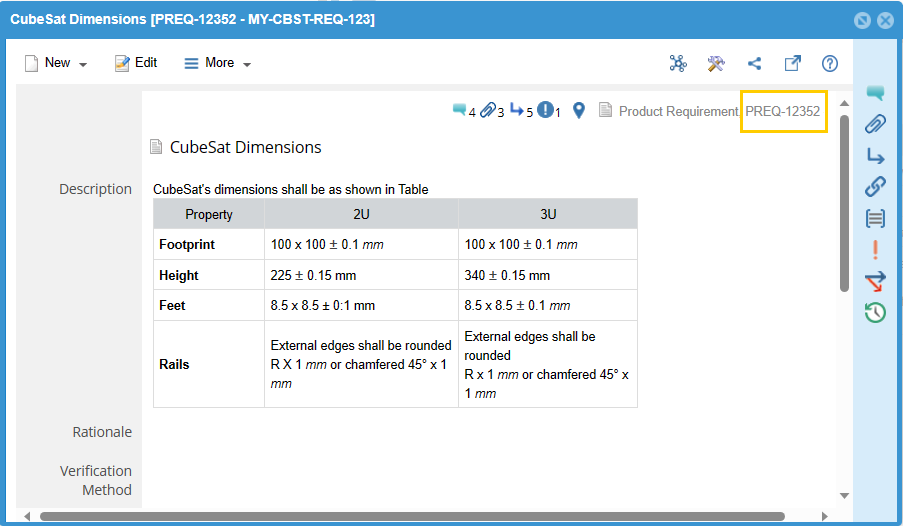
How is it assigned
- This running sequence number is assigned to an artifact when it is created and it remains the same throughout the life of that artifact.
- This ID cannot be changed.
- All versions of an artifact have the same ID.
What happens when you branch, merge, or reuse artifacts
- When you branch or merge a project, the IDs of artifacts remains same as their corresponding source artifacts.
- When you reuse an artifact, the ID of the artifact remains the same even if you de-link it from its source artifact.
When to use it
- Use it when you want to identify an artifact in the repository uniquely.
- You can use this ID in the Open Record window in the Desktop App to open the corresponding artifact. You can do this by pressing Ctrl+O and enter ID.
In the Web App, you can enter ID in the search box to fetch that artifact in the search result.
Ref. ID
For repository artifacts, you can assign a Ref. ID to an artifact, i.e., it is user-enterable.
- Format: %Ref. ID%
It is a 25-character alpha-numeric string that is editable.

How is it assigned
- Ref. ID is empty by default when an artifact is created. You need to specify a Ref. ID for the artifact.
- The system DOES NOT check for its uniqueness.
- This ID remains the same when you create a branch or reuse an artifact. When you clone an artifact, it is set to empty in the newly created cloned artifact.
When to use it
Use it when you have imported artifacts from an external application so that you can correlate artifacts in TopTeam and external systems.
Project ID
Each project has an identifier (ID) associated with it. The ID prefix is fixed for project artifacts.
- Format: %PROJECT ID%
- Example: PRJ-10123
There are two parts to this ID.
- The ID prefix (PRJ)
- A numeric value (10123).
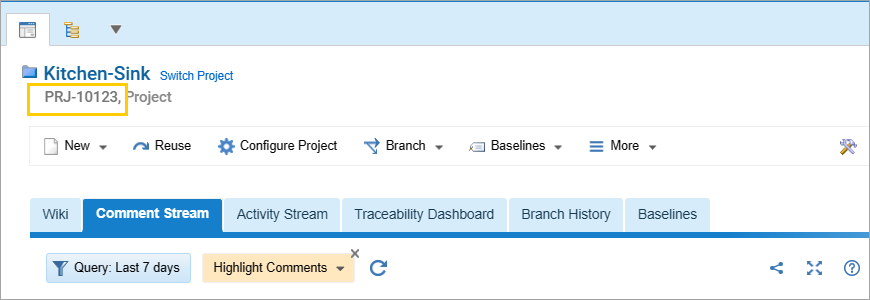
How it is assigned
- This running sequence number is assigned to a project when it is created and it remains same throughout the life of that project. This ID cannot be changed.
- A new ID is assigned to a project branch when a branch of a project is created. It is not the same as the ID of source project.
When to use it
Use it when you want to distinctly identify a project, as a project name can be the same in multiple projects.
Project Code
Project code is a 10-character code that you can assign to a project. This code should be unique across all projects (or project branches).
- Format: %PROJECT CODE%
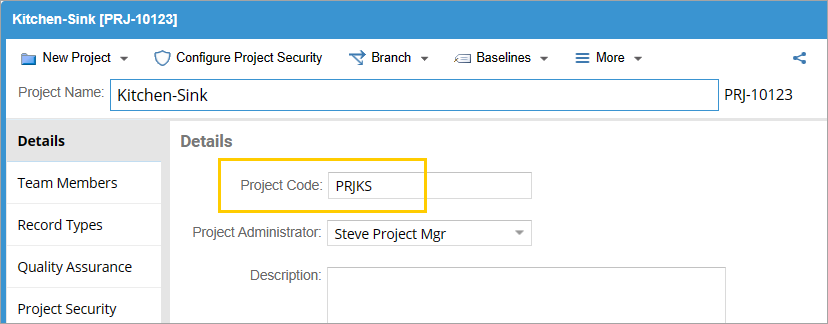
When to use it
Use it in Formatted ID of artifacts so that by looking at the Formatted ID, you know to which project an artifact belongs.
Package Code
Package Code is a 25-characters length field that you can assign to Components, Packages, and OneView Documents. Any characters can be specified for this field.
- Format: %Package Code%
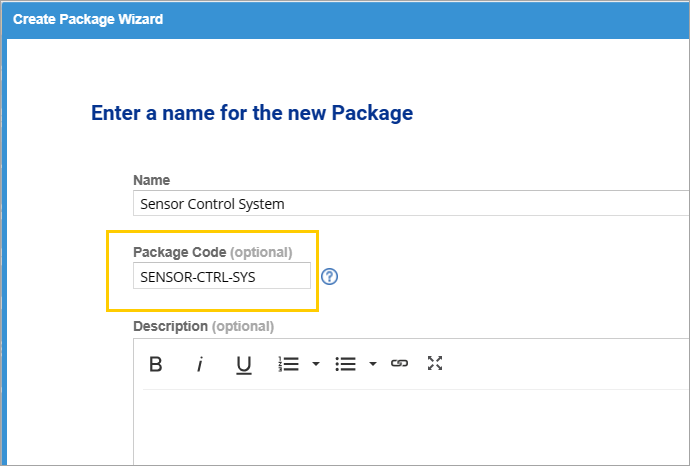
When to use it
You can use Package Code when you want to assign a code to a Component, Package or OneView Document.
All contents or artifacts of a Component, Package, or OneView Document have the same Package Code (including the child components and packages’ contents). So, you can use this field in the Disp. ID formula to dynamically build the Disp. ID. That way, by looking at an artifact in any interface, you can know the container of that artifact.
Package Code can be overridden at any child component or package level with any other value or even you can set it to empty.
| ONLINE HELP
|
You can access detailed information about using Package Code from the link below: |
Disp. ID
Unlike the above IDs, Disp-ID is not saved along with the artifacts. This is an ID which is calculated prior to its display.
- Format: %DISP-ID%
- Example: %ID%-%Ref. ID%
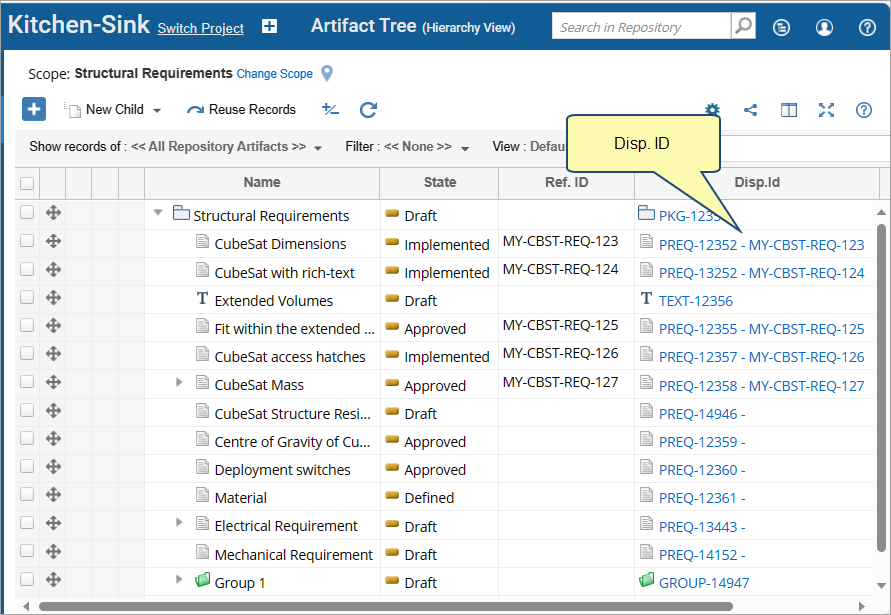
How it is assigned
You can customize Disp. ID in Global and Project settings what value you want to see for different type of artifacts in different projects.
Customizable Global and Project settings help you to define what is Primary ID for a record type in your organization and how you want to see it.
Global Settings
You can customize Global Setting “Custom Formatted ID” to change the way Disp-ID appears in different interfaces.
Project Settings
You can customize Project Settings “Custom Formatted ID” to change the way Disp-ID appears in different interfaces for artifacts of current project.
| ONLINE HELP
|
You can access detailed information about configuring “Custom Formatted ID” at system and project levels from the link below: |
| INFO
|
You can specify Disp. ID in settings for formatted title of artifacts or in inserted links, just like other identifiers. |
